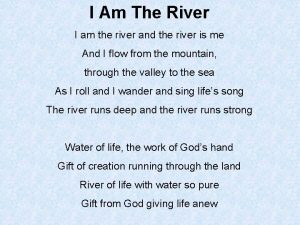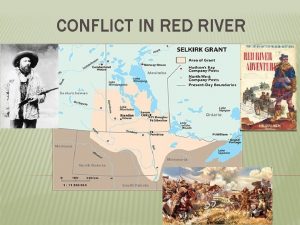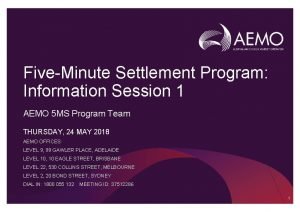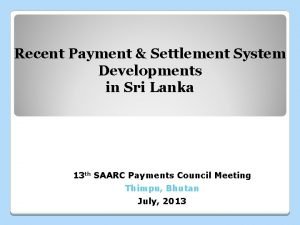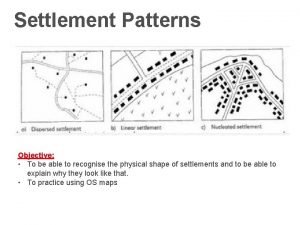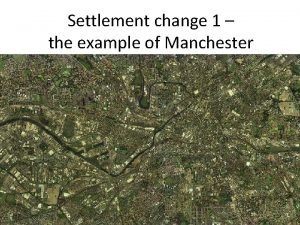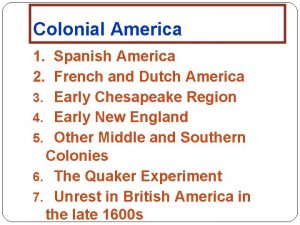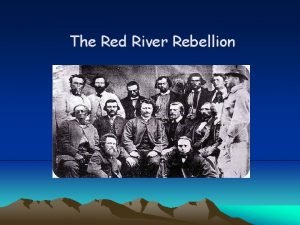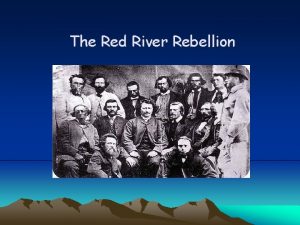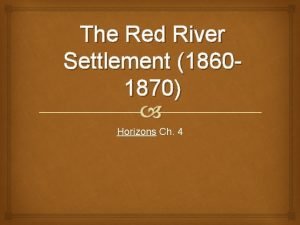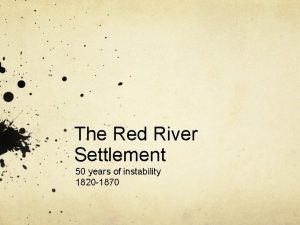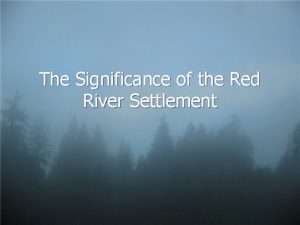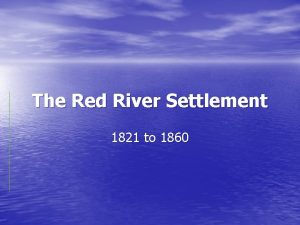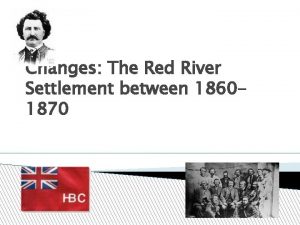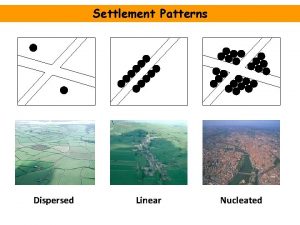Red River Red River Settlement Red River Settlement

















- Slides: 17

Red River

Red River Settlement • Red River Settlement was founded in 1812 by Thomas Douglas (also known as Lord Selkirk). Douglas, a Scottish nobleman, wanted to create agricultural colonies for displaced Scottish farmers who had been forced off their rented land by landowners who wanted to raise sheep (wool was more profitable than rent).


Rupert’s Land • Douglas asked the British government for a land grant in the Red River Valley in Rupert’s Land, land that the British government had given the Hudson’s Bay Company for fur trading purposes. The British government refused Douglas’ request.

Rupert’s Land • Douglas was eventually able to gain access to the land when the price of HBC shares went down and he and Sir Alexander Mackenzie were able to buy enough shares to gain control of the HBC. • Douglas was now able to convince the HBC to grant him 300, 000 square kilometres of land in the valley of the Red and Assiniboine rivers (Manitoba).

What about the people who lived there? • The settlement disrupted the trading practices and supply routes of the NWC. • The Metis and First People were worried that the settlement would disrupt their traditional hunting practices and patterns, and that they would lose the land they had farmed for generations, because they technically didn’t have ‘legal’ rights to it. • It was feared that the settlers would run out of food during the winter (crops had failed the first year). As a result the Pemmican Proclamation was issued.

Pemmican Proclamation – This banned the sale and export of pemmican from the Red River. – The Metis relied on the proceeds of selling pemmican to the NWC, and were not happy. • NWC employees were also ordered to leave their posts in the Red River Valley within 6 months.

Trouble… • Metis and NWC harassed the colonists by burning buildings, trampling crops, and firing rifles at night. • By June all of the colonists had left the settlement but returned by the end of the summer. • A short-lived peace was made with the Metis and NWC by Colin Robertson (an HBC trader who had once worked for the NWC) • But the new governor (Robert Semple) attacked and burned then-empty NWC fort.

Rebellion • This convinced the Metis that the colonists intended to declare war on them. – In response, the Metis attacked and killed Semple and twenty of his men (The Battle of Seven Oakes 1816) • The colonists again left the settlement • Douglas heard of the defeat. He then took military control of the area, allowing the colonists to again start their settlement. • Douglas (Selkirk) also made a treaty (1817) with the local Ojibwa and Cree nations gaining the possession of the Red River Valley.

The Red River Valley • By 1821, peace had come to the Red River Valley. It was an isolated and self-sufficient community with little direct contact with the outside world until the 1840 s. • By the 1860 s, more than 80% of the population was Metis.

Changes in the Red River Valley • More and more people from around Canada began to move because farmland was used up in Canada West. • The Red River Valley, with its fertile soil and established community was an appealing prospect.

New Arrivals • Most of the new arrivals were Protestant and members of the Orange Order, an anti-French, anti-Catholic movement. • There began to be a lot of racial tension in the Red River Settlement. • French Metis were discriminated against for their language and Catholic religion and the English-speaking Metis were discriminated against because of their First Nation heritage.

Rupert’s Land Again • Some politicians were interested in creating a Dominion of Canada, one that stretched from coast to coast. • Soon after Confederation in 1867, the Canadian Government and the HBC began negotiations to transfer control of Rupert’s Land because it was too expensive for the HBC. • The surveyors assumed that the riverside farms of Metis were not legally owned. • An agreement on the transfer of Rubert’s Land was signed in November 1869 re-naming the area the North-West Territories.

Land Ownership • Tensions were high in the Red River because people were angry that the land had been sold and their rights had been ignored. • Metis believed that if they cleared and farmed the land then they owned it. They did not possess “official” ownership of their land.

Louis Riel • Louis Riel was a Metis who had gone to Montreal to be educated • He came back a lawyer and fluent in both English and French. He was an excellent public speaker.


 Green river (duwamish river tributary)
Green river (duwamish river tributary) I am the river and the river is me
I am the river and the river is me Red river conflict
Red river conflict Red deer river basin
Red deer river basin Richard bilinski
Richard bilinski What is the river that separates texas and mexico?
What is the river that separates texas and mexico? Red river cart definition
Red river cart definition Settlement geography grade 12
Settlement geography grade 12 5 minute settlement
5 minute settlement Settlement patterns
Settlement patterns Long lot definition ap human geography
Long lot definition ap human geography Payment and settlement system in sri lanka
Payment and settlement system in sri lanka Settlement hierarchy pyramid
Settlement hierarchy pyramid Settlement patterns.
Settlement patterns. Life settlement solutions
Life settlement solutions Settlement hierarchy
Settlement hierarchy Sensys easy pay
Sensys easy pay Jamestown settlement
Jamestown settlement

